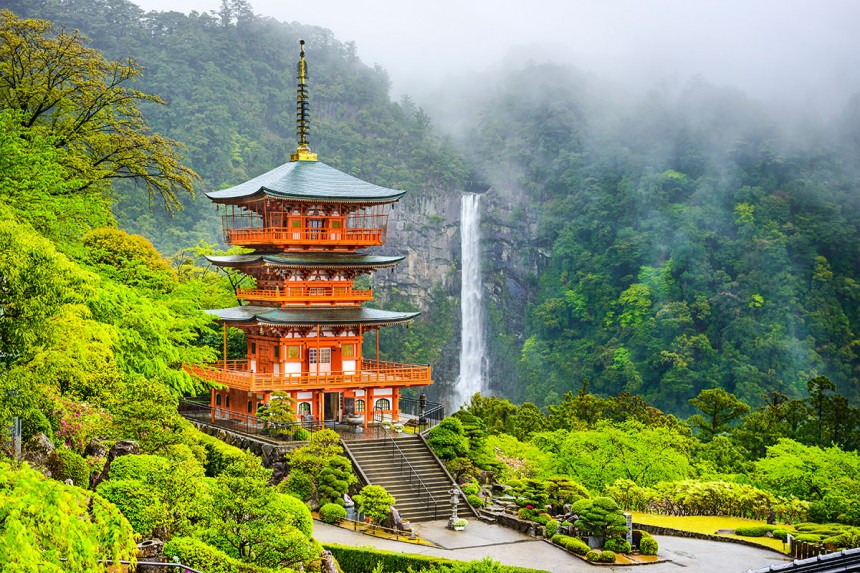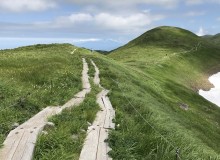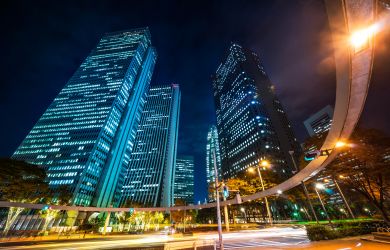
January 18, 2015

Reborn In Kumano
Refreshing body, mind and soul in Wakayama prefecture
A scenic landscape, healing hot springs, ancient spiritual traditions and an air of mystery—this is Kumano, a hidden gem buried deep in the mountains of the Kii Peninsula in the southern part of Wakayama prefecture.
For over one thousand years, Kumano has attracted worshippers who walk along the ancient Kumano Kodo (“Kumano Old Road”) pilgrimage routes to reach the sacred sites of the Kumano Sanzan, the Three Grand Shrines of Kumano, where locals welcome seekers with a warm heart and gentle hospitality. Anyone is welcome to travel the old pilgrimage routes irrespective of religious faith or social background. This has not changed over the centuries.

Kumano has spectacular natural sights in the mountains and along the coastline. Added to these are the old charm of a Japanese countryside still largely unspoiled by urban sprawl and a plenitude of exciting outdoor activities.
This makes Kumano an ideal place for a weekend retreat to regain your balance or for a discovery tour of a part of Japan that not even many Japanese know.
Godai, the five elements, act like a frame that captures the essence of Kumano, a place steeped in the ancient tradition of nature worship. Soaking up the atmosphere of earth, water, fire, air and heaven in Kumano’s magnificent natural and spiritual surroundings will stimulate your senses. And maybe, yomigaeri—being reborn in this very lifetime, the ultimate goal of undertaking the hardship of a Kumano pilgrimage—is within reach.
While in former times pilgrims walked for many months across steep mountains and deep valleys to reach this remote area, access nowadays is easier. With a flight of just over one hour from Haneda you are at the doorstep of a different world.
I first set out to walk the Kumano Kodo several years ago. Whether it was love at first sight, or en ga aru (to be linked by faith), I am not sure, but I moved to Kumano. I now guide visitors—both spiritual seekers and recreational hikers— along the old trails and to the ancient shrines. Follow me on a discovery tour of Kumano …
Introducing Kumano

Kumano Sanzan is the collective name given to the Three Grand Shrines of Kumano: Kumano Hongu Taisha, Kumano Nachi Taisha and Kumano Hayatama Taisha. These are the center points of the Kumano faith, a fusion of Shintoism and Buddhism called Shinbutsu-shugo.
Ascetic monks and wandering saints opened up the Kumano Kodo routes. They were followed by Imperial Court nobles and aristocrats from Heian-kyo, now Kyoto, in the Heian period (794-1185). During the Edo period (1603-1868) it was commoners from all walks of life who undertook the long and arduous journey at great peril. Most of the trails fell into disuse during the last century but were revived following the 2004 inscription of the World Heritage Site “Sacred Sites and Pilgrimage Routes in the Kii Mountain Range.”
Sections of the routes were paved with stones, and these stone-pavements and steps are now the trademark of the Kumano Kodo. They are a challenge to traverse, however, as they’re often overgrown with moss and are slippery. Many grave markers along the routes remind of the hardships of pilgrims in previous centuries. Don’t think a hike along the Kumano Kodo is all too easy, now; some trails are still fairly isolated and there are not many facilities along the way. Be prepared!
On Sacred Soil

(Photo by Alena Eckelmann)
The most accessible and well sign-posted route is the Nakahechi, which leads from Tanabe to Hongu. Walking the whole stretch of roughly 40 kilometers takes two days, hence it’s common to split the course into two separate one-day hikes. The Nakahechi course is largely snow-free, making it possible to walk even in winter.
The start is at Takijiri-oji, a short bus ride from Tanabe. Oji, or small shrine, were places for prayer and purification on the way to the main sanctuary. Once there were 99 oji along the Kumano Kodo, starting in Kyoto and ending at the Hongu Taisha. Five of these oji were of higher importance, serving as important gateways to the inner sanctuary. Takijiri-oji was one of them, and pilgrims would perform prayer and purification rituals there.
Nowadays you have wooden trail markers set in intervals of about 500 meters. The Nakahechi course has 75 markers, with the first at Takijiri-oji and the last at the Hongu Taisha. There are also many signboards in English that explain the historical significance of sites along the trail, allowing you to dive into the local history and the legends of the Kumano Kodo. Relax your senses and you might feel the spirits of nature around you along with the aura of pilgrims who have walked the trails before.
Nestled in a valley, Chikatsuyu Village is the halfway point to Hongu and a popular place for an overnight stay. There you can stock up on provisions for the next stretch off the trail, which is quite isolated. Further on, from Hosshinmon-oji to the Hongu Taisha, runs the most popular part of the Nakahechi. This is a gentle course that everyone can walk, ideal for a half-day excursion on the Kumano Kodo.
The trail passes through picturesque Hosshinmon Village and Fushiogami Village. Life here is quiet and slow. You can observe locals working in their gardens or tending their terraced paddy fields and tea plantations. It feels like catching a glimpse of Japan 50 years ago.
The Hongu Taisha now sits on higher ground but its original location was on Oyunohara, a sandbank at the conflux of three rivers. The buildings were relocated, but a giant iron torii gate marks the original sacred site. This is the world’s largest torii, and you feel small and humble standing underneath it. One of the best views to see this impressive sight from afar is from a lookout point off the Nakahechi route near Hongu.
Water Perspectives

Traditionally pilgrims worshipped at the Hongu Taisha first, then they made their way down the Kumano-gawa River to Hayatama Taisha, followed by a sea voyage to access Nachi Taisha. Part of the Kumano River is included in the UNESCO World Heritage Sites, and visitors can enjoy a ride in a traditional small wooden boat down the river just as pilgrims did centuries ago. The trip starts at the Kawabune Boat Tour Center in Kumanogawa Town and ends near Hayatama Taisha in Shingu City.
Visitors nowadays catch a train and bus to get to Nachi Taisha and nearby Nachi Waterfall. With a drop of 133 meters, this is the tallest waterfall in Japan and one of Kumano’s most impressive sights. One ton of water per second gushes down. Ascetics used to practice cold water purification under this thunderous veil of water.
Thrill-seekers should not miss the only chance in all of Japan to experience traditional log rafting down the rapid currents of Kitayama River. If you don’t like getting splashed, a trip on a jet boat to scenic Dorokyo Gorge further downstream might be for you. While these are not part of the pilgrimage tradition, they make for exciting side trips.
Hot Happenings

Kumano has many exciting events throughout the year, but my favorites are the fire festivals, which are amongst Japan’s most spectacular.
Kamikura-jinja sits atop a large boulder overlooking a cliff. A steep flight of over 500 stone steps leads up to the shrine, Shingu’s best observation point. This is the setting for the Kumano Oto Festival, a 1,400-year-old ritual to welcome the new year according to the lunar calendar.
On February 6, around 2,000 men of all ages decked out all in white—the color of purity—gather at the shrine after dusk. (Only men are allowed to participate, now including foreigners.) They each light a one-meter cypress torch and, upon signal, race down the steps. Seen from afar, it looks as if a fire-breathing dragon is winding its way down the mountainside.
Half a year later, on July 14, the Nachi Fire Festival is held alongside the Nachi Waterfall. Twelve massive, 50kg pine torches are carried up and down the flight of stone steps leading to the waterfall by young men decked out in traditional white gear. The heavy torches are waved around to purify an equal number of mikoshi (portable shrines). Steeped in nature worship, this euphoric event is held to welcome the god of the Nachi Waterfall back to its base.
Heavenly Bliss

(Photo by Alena Eckelmann)
No trip to Kumano is complete without soaking in a hot spring. My favorite places for relaxation are three hot spring villages near Hongu Town.
With 1,800 years of history, Yunomine Onsen is probably Japan’s oldest hot spring, and here the main attraction is Tsuboyu, a hot spring pool located in a small hut above a creek. It has space for a maximum of three people and can be rented for private use for 30 minutes at a time.
The water is neither filtered nor heated, so you bathe in the original bubbles that come straight from the center of the earth. What is floating in the water is not dirt but yu-no-hana (onsen flowers), crystalline mineral compounds, the ultimate proof of a real hot spring. Visitors can stay at one of the traditional inns that line the only road in this quaint village where they can experience an authentic Japanese spa unspoiled by mass tourism.
Hot spring bathing at Kawayu Onsen is as public as it gets. Thermal water bubbles to the surface of Oto River, creating a natural outdoors bath where you sit in a pool in the riverbed. Until the end of February, you will not be alone there when Sennin Buro, a thousand-people bath dug in the river bed, is open for business.
Whether you choose to stay at a small traditional inn with a 200-year history, or feel comfortable in the modern environment of a popular hotel, all accommodations at Kawayu have a great river view—perfect for winding down and sipping a cup of sake after a long day’s hike.
If you prefer a little onsen luxury, then Wataze Onsen is the right choice. It boasts the largest rotenburo open-air hot spring in Western Japan. Three outdoor pools with water of varying temperature make it easy to hang out there for a couple of hours and watch the stars at night. Families or couples can enjoy a private rotenburo. At nearby Kurhaus Kumano Hongu you can sample eight different indoor pools.
Food for Walk

Out on the Kumano Kodo routes there won’t be many places where you can buy food, so be prepared and take along a lunch box. Mehari Zushi (sushi wrapped in pickled mustard leave) and Sanma Zushi (sushi made from Pacific saury) are popular, and you can buy them at shops in Tanabe or Hongu.
I recommend the Kodo Lunch Box, prepared on request by Omuraya Minshuku and delivered to your accommodations in the Hongu area. The traditional bamboo basket is crammed full of local delicacies.
In Yunomine, you can cook provisions for the hike yourself. Buy eggs and sweet potatoes in a net at the local store and hang them in the Yuzutsu Cooking Basin. By the time you have finished soaking in the bath, your food for the next day is ready.
Kumano beef might not be as famous as Kobe beef, but it’s just as delicious. Grilled Kumano beef bowls are offered at various restaurants in Ajikoji, an area near Tanabe station packed with Izakaya (Japanese-style pubs). There you will also find delicious local seafood fresh from the ocean off the coast of the Kii Peninsula. Try the Kishu Fresh Seafood Bowl. The Tanabe City Gourmet Map and the Tanabe Special Rice Bowl Menu help you select your favorite local dishes.
On the other side of the peninsula, in Katsuura, a feast of fresh tuna awaits. West Japan’s biggest catch of tuna is delivered to Katsuura Fishing Port where every morning the fresh catch is laid out at the Katsuura Fish Market. Watching the tuna auction from an observation area at 7am (closed Saturdays) is exciting. No queuing in the middle of the night like at Tsukiji! Follow up with a delicious Fresh Tuna Rice Bowl at any of the seafood restaurants that line the street leading to Katsuura station.
Healing in the Air

Fresh air is in ample supply in Kumano where mountains are covered by lush green forest all year round. The deep calmness of the forest is soothing. No wonder shinrin-yoku (bathing in the forest) is popular among Japanese visitors. Kumano has the perfect environment for this form of eco-therapy, and meditation in the great outdoors.
Yakuzen-ryori (medicinal cuisine) is the specialty fare offered at the inns of nearby Kawayu Onsen. The dishes contain seasonal herbs and wild vegetables collected by locals from the surrounding forests.
Jizo is a Buddhist deity that protects travelers and children, and along the Kumano Kodo trails you can see many statues of this divine being. The Toothache Jizo and Backache Jizo on the Nakahechi trail at Mizunomi-oji are easily overlooked, but locals strongly believe they have the power to cure these ailments.
Taxi Campaign
Until the end of October 2015, visitors traveling to Kumano via airplane to Nanki-Shirahama Airport can benefit from a generous discount (amount varies by service). To qualify, fill out a questionnaire and give it to a cab driver.
Book your selected course at the information desk at Nanki-Shirahama Airport upon arrival and take off on an exciting half-day or full-day excursion to the wider Kumano area in no time. Prices vary depending on car type and duration of ride. http://meturl.com/kumanotaxi (in Japanese only)
Top-notch Travel Services
Your quick-access gateway to Kumano is Nanki-Shirahama Airport which is served with three flights a day by Japan Airlines (www.jal.co.jp/en) departing from Haneda.
The airport is located near theme park Adventure World Shirahama. Five adult Giant Pandas and two baby Giant Pandas, born in December 2013, live here. This is the most Giant Pandas in one place outside China. (http://aws-s.com/english/index.php).
A short trip by taxi or local bus gets you from the airport to Tanabe station, the transportation and information hub for the Kumano area. English-speaking staff at Tanabe City Kumano Tourism Bureau right by the station will help you with transportation and accommodations information and bookings. You can also book all aforementioned accommodations and activities in advance online using their excellent website (www.tb-kumano.jp/en/).
For busy Tokyoites with little time to organize travel, JALPAK (www.jal.co.jp/domtour/kas/sekaiisan_kumano) offers 2- or 3-day package deals, including flight, sightseeing by taxi and accommodation. Apply online (in Japanese only).
If you travel as a group with family or friends, an easy way to get around is the flat-rate Hired Taxi Plan. Until the end of October, visitors who travel to Kumano via airplane to Nanki-Shirahama Airport can benefit from a generous discount (amount varies by service). To qualify you must fill out a questionnaire and give it to your driver. Book your selected course at the Information Desk at Nanki-Shirahama Airport upon arrival and take off for an exciting half-day or full-day excursion to the wider Kumano area in no time. Prices vary depending on the type of car and duration.
For those who do not want to splash out on hired transportation, the public buses serve you well. Bus routes and timetables in English can be found on the website of the Tanabe City Kumano Tourism Bureau (www.tb-kumano.jp/en). Arrive with the JAL morning flight and catch the express bus from the airport all the way to Shingu, via Tanabe, Takijiri-oji, Chikatsuyu and Hongu (www.meikobus.jp/pdf/4.1.koushin/kumanokodo/zikoku.untin/kumanokodou_zikoku_10_1.pdf).
For adventurous travelers eager to go off-the-beaten path, hiring a rental car and driving themselves is the best option to get around. Car rental services are available at Nanki-Shirahama Airport and at Tanabe station. Some cars are equipped with English GPS to facilitate easy navigation. Kumano is a driver’s heaven and once you’ve left the urban areas behind, there won’t be any traffic lights for miles on end!
Whatever method of travel you choose, enjoy your time in Kumano!
For more information about the Kumano area and services for visitors see the following websites:
Wakayama Tourism Federation (Area Information and List of Licensed Tour Guides)
Tanabe City Kumano Tourism Bureau (Transport, Accommodation, Rental Car and Services Bookings)
Mi-Kumano (English Speaking Guides)







